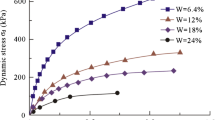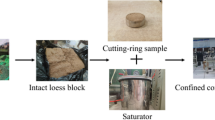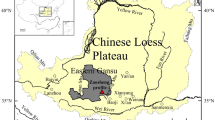Abstract
The predominately, wind-derived deposits forming the Loess Plateau in China are known as Wucheng loess (Q1), Lishi loess (Q2), and Manlan loess (Q3). Only Q3 loess has been intensely studied in densely populated areas, revealing that the structural strength of these aeolian sediments is directly related to their variations (anisotropy) in compressibility, water content, and, particularly, vertical jointing. Knowing the stability level of Q3 aeolian sediment is important in tunnel constructions through other types of loess. The research reported here has been mainly centered on obtaining the values of consolidation, unconfined compressive strength (UCS), direct and triaxial shear tests, Poisson’s ratio, and modulus of deformation of the Q2 loess in the Baijiapo Tunnel on the Lanyu Railway, Lanzhou, China. Included among the numerous results of these comprehensive laboratory tests are: the mean index of liquidity is 0.19; and the maximum modulus of compression in the vertical direction is 1.17. Furthermore, vertical and horizontal samples showed brittle fracture; the ratios of UCS and modulus of deformation in the vertical to the horizontal directions are 1.34 and 2.45, respectively. The wide range of various values of Lishi loess properties are closely related to variation in the density of the vertical jointing system. A new method for calculating comprehensive shear parameters is proposed and the related parameters for the Baijiapo Tunnel are recommended.











Similar content being viewed by others
References
Chen ZY, Zhou JX, Wang HJ (1994) Soil mechanics. Tsinghua University Press, Beijing
Das BM (2006) Principles of geotechnical engineering, 6th edn. Nelson, Canada
Dijkstra TA (2001) Geotechnical thresholds in the Lanzhou loess of China. Quat Int 76(77):21–28
Dijkstra TA, Rogers CDF, Smalley IJ, Derbyshire E, Li YJ, Meng XM (1994) The loess of north-central China: geotechnical properties and their relation to slope stability. Eng Geol 36:153–171
Fang XW, Chen ZH, Shen CN, Wang HW, Liu HJ (2008) Triaxial shear properties of undisturbed Q2 loess. Chin J Rock Mech Eng 27(2):383–389
Fang QB, Ma JL, Yu Y, Yang JM, Wang XD (2009) Experimental research on elastic resistant coefficient, deformation and compressive modulus of surrounding rock in large-section loess tunnel. Chin J Rock Mech Eng 28(Suppl 2):3932–3937
Fang XW, Shen CN, Chen ZH, Zhang W (2011) Triaxial wetting tests of intact Q2 loess by computed tomography. China Civ Eng J 44(10):98–106
Feng LC, Zheng YW (1982) Collapsible loess in China. Chinese Railway Publishing House, Beijing, pp 12–74
Gao GR (1996) The distribution and geotechnical properties of loess soils, lateritic soils and clayey soils in China. Eng Geol 42:95–104
He QF (2008) Study on the mechanical and rheological properties of Yan’an Q2 loess. PhD thesis, Chang’an University, Xi’an
Hu ZQ, Shen ZJ, Xie DY (2004) Deformation properties of structural loess. Chin J Rock Mech Eng 23(24):4142–4146
Kalinski ME (2005) Soil mechanics laboratory manual. Wiley, USA
Li BX, Miao TD (2006) Research on water sensitivity of loess shear strength. Chin J Rock Mech Eng 25(05):1003–1008
Liang QG, Zhao L, An YF, Zhang YJ (2011) Preliminary study on anisotropy of Q4 loess in Lanzhou. Rock Soil Mech 33(1):17–23
Lin CY (1961) Penetration test on loess in Lanzhou. In: Study on fundamental properties of loess, by Research Office of Institute of Civil Construction, Chinese Academy of Sciences. Science Publishing House, Beijing, pp 95–103
Lin ZG, Liang WM (1980) Distribution and engineering properties if loess and loess-like soils in China: schematic map of engineering geological zoning. Bull Int Assoc Eng Geol 21:112–117
Lin ZG, Wang SJ (1988) Collapsibility and deformation characteristics of deep-seated loess in China. Eng Geol 25:271–282
Ling RH, Han BC, Qu YX (1996) Excavation effect of large-span deep buried loess tunnel. J Eng Geol 4(3):65–70
Liu ZD (1997) Mechanics and engineering in loess, vol 1–18. Shan’xi Science and Technology Publishing House, Xi’an, pp 366–389
Liu YR,Tang HM (1999) Rock mass mechanics. China University of Geosciences Press, Wuhan
Lu QZ, Peng JB, Chen ZX, Li XA (2005) Research on characteristics of cracks and fissures of loess and their distribution in Loess Plateau of China. J Soil Water Conserv 19(5):191–194
Mi HZ, Li RM, Niu JX (2006) Experimental investigation of shear strength characteristics of intact loess in Lanzhou. J Lanzhou Univ Technol 32(4):109–111
Milovic D (1988) Stress deformation properties of macroporous loess soils. Eng Geol 25:283–302
Qian HJ, Wang JT, Luo YS (1985) Foundations on collapsible loess. China Architecture Industry Publishing House of Beijing, Beijing, pp 20–50
Qiao PD, Li ZJ (1990) Engineering geology in loess areas. Water Conservancy and Electric Power Publishing House, Beijing, pp 52–60
Ramamurthy T (2004) A geo-engineering classification for rocks and rock masses. Int J Rock Mech Min Sci 4:89–101
Shao SJ, Deng GH (2008) The strength characteristics of loess with different structures and its application in analyzing the earth pressure on loess tunnel. China Civ Eng J 41(11):93–98
Sun GZ (1997) Collected works of Guangzhong Sun on geological engineering. Weapon Industry Publishing House, Beijing, pp 223–257
Sun JZ (2005) Loessology: part 1. Press of Archeology Society of Hong Kong, Hong Kong, pp 1–80
Tan T (1988) Fundamental properties of loess from Northwestern China. Eng Geol 25:103–133
Tang H, Dang Q, Duan Z, Zhao FS, Song F (2014) Study on creep characteristics of Q2 loess of Xianyang Area in the Guanzhong Basin. J Disaster Prev Mitig Eng 34(6):758–763, 770
The 1st Design Institute of China Ministry of Railway (1975) Manual of tunnel design in railway engineering. People’s Railway Press, Beijing, pp 391–399
The National Standards of People’s Republic of China (1999) Standard for soil test method (GB/T50123-1999). China Planning Press, Beijing
Wang JM (1996) The theory on tectonic joints in loess and its application. China Water Conservancy and Hydropower Publishing House, Beijing, pp 15–23, 148–165
Wang YY, Lin ZG (1990) Structural characteristics, physical and mechanical properties of loess in China. Science Press, Beijing
Wang JM, Ni YL, Sun JZ (1994) A study on structural joints in loess and its practical applications. J Eng Geol 2(4):31–42
Wu WJ, Chen WW, Song BH, Feng LT, Ye WL (2012) Experiment on the shear characteristics of undisturbed Q2 loess in Lanzhou. J Lanzhou Univ (Nat Sci) 48(6):21–25
Xie DY (2001) Exploration of some new tendencies in research of loess mechanics. Chin J Geotech Eng 23(1):3–13
Xie X, Zhao FS, Wang YT, Lin B, Wang DH (2006) Comparative study on mechanical features of structural Q2 and Q3 loess. J Xi’an Univ Sci Technol 26(4):451–455, 468
Zhang W (1995) Discussions on mechanical test for loess. Geotech Investig Surv 3:6–12
Zhang FY, Wang GH, Kamai T, Chen WW, Zhang DX, Yang J (2013) Undrained shear behavior of loess saturated with different concentrations of sodium chloride solution. Eng Geol 155:69–79
Zhang FY, Wang GH, Kamai T, Chen WW (2014) Effect of pore-water chemistry on undrained shear behaviour of saturated loess. Q J Eng Geol Hydrogeol (online first)
Zhong ZL (2008) Study on constitutive model of Q2 intact loess and its application in tunnel engineering. PhD thesis, Chongqing University, Chongqing
Zhong ZL, Zhang J, Liu ZL, Fang JB, Zhou Y (2011) Test on engineering properties of unsaturated undisturbed loess Q2. J Chongqing Univ 34(2):120–124
Acknowledgments
This study was partially supported by the National Science Foundation of China (41262010 and 41402252), the Program for Changjiang Scholars and Innovative Research Team in University (IRT1139), China, and the Foundation for Basic Research Innovative Groups of Gansu Province, China (145RJIA332). The authors also appreciate the editor and referees for their valuable comments that led to substantial improvement of this paper.
Author information
Authors and Affiliations
Corresponding author
Rights and permissions
About this article
Cite this article
Liang, Q., Li, J., Wu, X. et al. Anisotropy of Q2 loess in the Baijiapo Tunnel on the Lanyu Railway, China. Bull Eng Geol Environ 75, 109–124 (2016). https://doi.org/10.1007/s10064-015-0723-z
Received:
Accepted:
Published:
Issue Date:
DOI: https://doi.org/10.1007/s10064-015-0723-z




